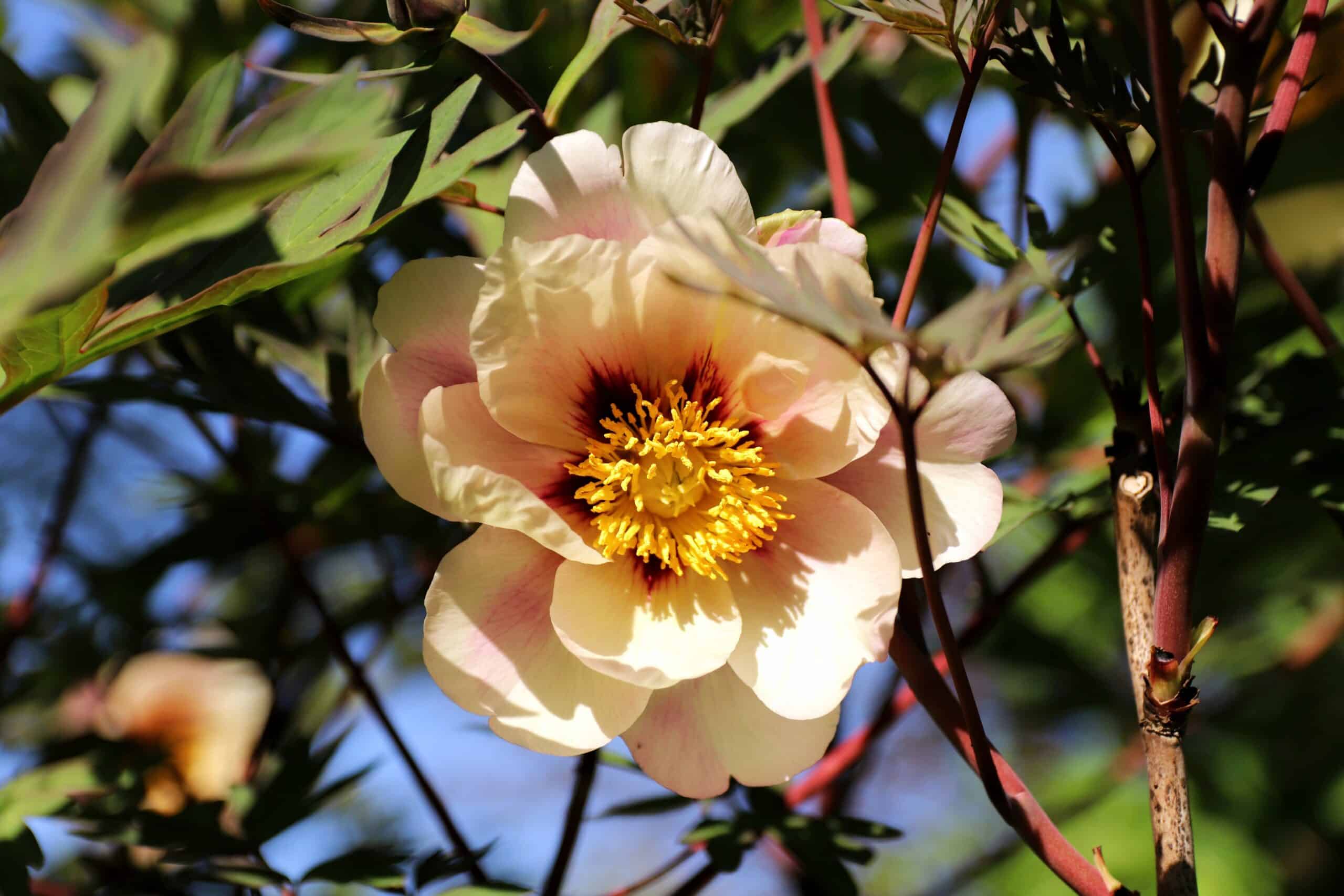Tree peonies are a rare and beautiful flowering plant that bring color and vibrancy to any garden. With proper care and maintenance, these plants can provide years of enjoyment. As specialist in botany and gardening, I am here to provide the necessary information for growing and caring for tree peonies.
Tree peonies come in many varieties, from the delicate pink of ‘Kakoden’ to the deep purple shades of ‘Murasaki-kumo’. They range in size from the small ‘Shimane-no-mai’ to the larger ‘Shiranui’. No matter what variety you choose, you will be sure to have a stunning addition to your garden.
The key to successful growth is understanding how best to plant, prune, water and fertilize your tree peony. In this article, I will provide detailed instructions on how to grow and care for these plants so that they can thrive in their new home. With a little bit of knowledge and patience, you can create an amazing display of blooming flowers with your tree peonies!
Selecting And Buying Tree Peonies
Selecting and buying tree peonies is an important decision. These gorgeous flowers can live for decades, so it’s important to make sure you get the right kind for your climate and garden conditions. When shopping for a tree peony, look for healthy, vigorous plants with no signs of disease or damage. Make sure to ask about its water needs and soil requirements to ensure that it will thrive in your garden.
The most important factor when choosing a tree peony is its hardiness zone. Choose a variety that’s suited to your area’s climate; otherwise, it won’t survive the winter months. It’s also wise to choose one that will flower in the late spring or early summer since these blooms last longer and are more fragrant than those that bloom later in the season. Once you’ve found a variety that meets your criteria, take some time to inspect the root system carefully before making your purchase.
When buying a tree peony, always go with quality over quantity. A smaller plant may be cheaper up front but will require more care and attention in order to thrive than one that’s already established and well-rooted. Investing in a healthy plant now means less work later on down the line! With proper selection and care, you’ll be rewarded with vibrant and beautiful blooms year after year. With these tips in mind, you’re ready to begin planting your new tree peony!
Planting Tree Peonies
Planting tree peonies is an important step in providing them with the care they need for a healthy life. To ensure success, there are several key factors to consider. First, it is essential to select a suitable location for the tree peony and prepare the soil for planting. Second, planting should be done at the correct time of year according to your local climate. Third, being aware of how deep to plant and when to prune will help keep your tree peonies healthy and looking their best. Finally, incorporating mulch into the soil can provide additional protection from extreme temperatures and pests.
To plant your tree peony:
• Choose a site that has some morning sun exposure and well-draining soil. • Test the soil pH levels to ensure they are between 6 and 7 on the pH scale. • Dig a hole twice as wide as the root ball of your tree peony. • Mix compost or other organic matter into the backfill of soil before filling in around the roots. • Water deeply once planted, ensuring that all of the roots are soaked fully.
Planting your tree peony in its ideal environment can help it thrive for years to come. Taking into account environmental factors such as temperature and moisture levels can be beneficial for promoting growth and health for this type of flower species over time. With adequate care and maintenance, you can create a beautiful garden featuring these lovely plants!
Site Selection For Tree Peonies
Selecting the right site for planting tree peonies is essential. It will ensure that your plants bloom and thrive to their fullest potential. As a specialist in botany and gardening, I’m here to guide you through the process of choosing the ideal location for your tree peonies.
First, make sure to pick a spot with plenty of sunlight. Tree peonies need at least six hours of direct sunlight each day to develop big and beautiful blooms. Avoid areas with too much shade or trees that cast shadows on the area throughout most of the day. Additionally, it’s important to consider how much wind the area gets as well, since strong winds can cause damage to your plants’ foliage.
Next up is soil quality. Well-draining soils are best for tree peonies – it’s important to avoid waterlogged soils or those which stay damp for long periods of time after rain or watering. Aim for neutral pH levels around 6-7, as soil with a higher pH can lead to nutrient deficiencies in your plants. With these tips in mind, you’ll be well on your way towards selecting the perfect spot for your tree peony garden!
Soil Preparation For Tree Peonies
Soil preparation is an essential part of growing and caring for tree peonies. It’s important to select the right type of soil, as well as prepare it correctly, in order to ensure successful growth.
When selecting a suitable soil for tree peonies, look for a well-drained mix that has good aeration and organic matter. This can be achieved by adding compost or aged manure to the existing soil. You should also amend your soil with sulfur or iron sulfate to reduce alkalinity, if necessary. In addition, make sure there are no weeds in the area where you’ll be planting your tree peony.
To further prepare the soil for tree peonies, dig a planting hole that’s wide and deep enough to accommodate their root system and then work some compost into the bottom of it before carefully setting your plant in place. Finally, backfill the remaining space with good quality topsoil or composted material and press firmly around the roots. With proper soil preparation complete, you’re now ready to focus on water requirements for tree peonies.
Water Requirements For Tree Peonies
Soil preparation is essential for growing tree peonies, but so is water. To ensure optimal health and growth, it’s important to understand the water requirements of these beautiful plants. Juxtaposed against soil preparation, water needs must be understood to provide proper care for tree peonies.
Tree peonies should be watered deeply but infrequently. It’s best to give them a deep soaking once or twice a week when there is no rain. This helps encourage root development and gives the plant more access to the moisture it needs. Additionally, watering at ground level helps reduce leaf diseases from fungal spores that may be in the air during wet periods. Avoid overhead watering if possible because of this risk of disease; however, if overhead watering is necessary due to lack of other options, then do so early in the day so leaves can dry before nightfall.
Mulching tree peonies can also help conserve moisture in the soil around the plants and prevent weeds from competing with them for nutrients and water. A good organic mulch such as wood chips will provide additional organic matter and keep weeds at bay while helping retain moisture in the soil throughout hot days. TIP: Check your soil with a moisture meter before watering or applying mulch to avoid over-watering or drowning your plants!
Fertilizing Tree Peonies
Fertilizing tree peonies is an important part of their care in order to ensure they reach their full potential. Knowing when and how much to fertilize, as well as what type of fertilizer to use, will help you maximize the health and beauty of your tree peony. Here are some tips to get you started:
First, it’s important to choose a fertilizer that is specifically designed for trees and shrubs. Look for a formula that contains all three macronutrients – nitrogen, phosphorus, and potassium – in equal amounts or slightly higher nitrogen content. This will provide your tree peony with the nutrients it needs for healthy growth.
When applying fertilizer, do so early in the season before new growth begins. Spread the fertilizer evenly around your tree peony at a rate of 1/2 pound per 10 square feet area or according to package directions. Water the plant afterwards to help activate the fertilizer and release its nutrients into the soil.
Finally, be sure you’re not over-fertilizing your tree peony by following these guidelines: • Fertilize annually with a balanced slow-release fertilizer in early spring • Don’t apply more than 2 pounds of total nitrogen per year for every 100 square feet area • Avoid liquid fertilizers as they can burn tender young shoots With these tips in mind, you can confidently fertilize your tree peony with confidence that it will thrive and produce beautiful blooms each season. Moving on from here, let’s look at how proper pruning will help keep your tree peony looking its best…
Pruning Tree Peonies
Pruning tree peonies is a necessary part of their care and maintenance, much like a fine-tuned machine needs regular check-ups. As the saying goes, ‘a stitch in time saves nine’, so it’s important to prune your tree peony at the right time of year. Here we will go through the basics of pruning and give you all the information you need to get started.
The best time to prune your tree peony is late winter or early spring, before growth begins and buds start to appear on your plant. During this period, cut off any dead or damaged branches that may be present, as well as any overcrowding or crossing branches. This will open up the canopy of your tree peony and allow light and air circulation to help keep it healthy. It’s also important to remove any suckers from the base of your plant that are taking away energy from its main stem.
You can also lightly shape your tree peony by removing some old stems, which will help encourage new growth each season. Make sure not to overdo it though – only remove around a third of the stems each year so that you don’t risk damaging it too much. With these steps in place, you should now have all the knowledge needed for properly pruning your tree peony! Transitioning into mulching; when done correctly, mulching can offer many benefits for keeping your plant healthy and thriving over time.
Mulching Tree Peonies
Mulching tree peonies is an important part of their care. It will prevent weeds from growing and help retain moisture in the soil. It also helps protect the plants from extreme temperatures, both hot and cold. Mulching should be done every spring when new growth begins to appear.
When mulching tree peonies, it’s best to use organic matter such as pine needles, shredded leaves, or wood chips. Spread a 2-3 inch layer around the base of the plant and make sure to leave enough space for air to circulate. This will help ensure that the soil stays moist and cool while providing necessary nutrients for healthy growth. Additionally, this will help control weeds that can compete with your tree peony for water and nutrients.
Another important factor to consider when mulching is that you don’t want to pile too much mulch around the crown of the plant as this can cause it to rot. Too little mulch won’t offer enough protection so be sure to balance these two factors for optimal results. With a bit of effort and patience, you can keep your tree peony looking beautiful year round with a healthy layer of organic mulch!
By taking the time to properly mulch your tree peony plants each spring, you’ll give them the protection they need against heat and cold while also controlling weeds and keeping soil moisture levels balanced. This will go a long way towards ensuring your plants stay healthy and vibrant throughout the growing season. Now let’s look at how we can control weeds and pests on tree peonies for even better results!
Controlling Weeds And Pests On Tree Peonies
As the saying goes: “A stitch in time saves nine” – and this is no less true when it comes to controlling weeds and pests on tree peonies. With a bit of diligence and attention, you can keep your peonies healthy and beautiful for years to come.
It is important to keep an eye out for any signs of pest infestations or weed growth that could weaken your plants’ health or detract from their beauty. If you spot anything suspicious, take action quickly to prevent the problem from spreading further. This can be done by removing weeds manually, or spraying an insecticidal soap solution over the affected area.
Also, be sure to apply a fertilizer with a balanced nitrogen-phosphorus-potassium ratio in early spring and late summer to encourage healthy growth and blooming. Keeping your tree peony’s bed free of debris will also help control pests and weeds while providing essential nutrients directly to the plant’s roots.
With these simple tips, you’ll have no trouble keeping your tree peonies happy and healthy! Now, let’s look at what other plants make great planting companions for these lovely blooms.
Planting Companions For Tree Peonies
Planting companions for tree peonies is a great way to provide additional support and beauty in the garden. When selecting companion plants, it’s important to consider factors such as their sun requirements, water needs, and height at maturity. For instance, shorter flowering perennials like iris or daylilies can be planted underneath tree peonies to help break up the soil and keep away weeds. Additionally, many gardeners prefer to use taller shrubs such as roses or hydrangeas around the perimeter of the tree peony bed in order to add more visual interest and create a sense of enclosure.
When planting companions near tree peonies, it’s essential that you take into account how much space each plant needs so that there’s enough room for them all to thrive. Too little space can lead to competition for nutrients, light, and water – so be sure to give each plant enough room! Additionally, try to select companion plants with similar water needs since different types of plants require different amounts of moisture throughout the growing season. Finally, when choosing trees or shrubs as companions for your tree peony bed, make sure they won’t reach too high in maturity as this could overshadow your beloved blooms and prevent them from getting enough sunlight!
By considering sun requirements, water needs, and height at maturity when selecting companion plants for your tree peony bed you can ensure that each one has enough room to grow while still providing additional beauty and support. With careful consideration and planning you will have a wonderful display full of vibrant blooms that will last throughout the growing season!
Propagating Tree Peonies
Tree peonies are like the most precious gems in a gardener’s collection. They bloom with breathtaking beauty, and their scent is as intoxicating as it is unforgettable. Propagating these beauties is no easy task, but with the right knowledge and technique anyone can achieve success.
For starters, you must choose a healthy parent plant to begin propagation. Make sure that the tree peony has plenty of buds and shoots – this will indicate that it’s in good condition and ready for propagation. Once you’ve chosen your parent plant, you’ll need to take cuttings from it. Take several healthy cuttings from the parent plant and trim off any excess leaves or stems at the base of each cutting. Then dip each cutting into rooting hormone powder before planting them into separate pots filled with soil mix specifically formulated for tree peonies.
When caring for newly propagated tree peonies, make sure to keep them moist but not soggy at all times. Watering once or twice a week should be sufficient; however, if there’s been an unusual amount of rain or heat lately then they may require more frequent watering sessions. You can protect your plants from extreme temperatures by using mulch or other types of protective covers such as shade nets or sun-reflective fabric during the hottest part of summer. Additionally, fertilizing about twice a year (once during spring and again in autumn) will help ensure that your newly propagated tree peony plants stay healthy and thrive for many years to come!
Supports For Tree Peonies
Tree peonies are a magnificent addition to any garden, but they require special attention and care. To ensure your tree peony is healthy and thriving, it’s important to support it in the right way. In this section, I’ll explain how best to provide support for your tree peony.
Properly providing support for your tree peony starts with selecting the correct type of stake. You should use stakes that are tall enough to reach 1-2 feet above the top of the plant when it’s fully grown. Stakes should also be strong enough to withstand weather and heavy winds without breaking or becoming damaged. It’s also important to place them deeply into the ground so they don’t move easily when pushed by wind.
Once you’ve chosen a suitable stake, attach it securely around the base of the plant using twine or string. Make sure the tie-off isn’t too tight as this can damage the stem or root system of your tree peony. You should also check and adjust ties periodically throughout its growing season as plants tend to grow quickly during this period and need more frequent adjustments.
Without proper support, a tree peony won’t be able to stand upright once it starts bearing flowers and fruits. By taking these simple steps you can ensure that your tree peony remains healthy, strong and beautiful for many years ahead! With these tips in mind, you’re now ready to learn more about common diseases of tree peonies…
Common Diseases Of Tree Peonies
Tree peonies are majestic plants, their blooms representing a pinnacle of beauty and grace. Unfortunately, this grandeur can often be hindered by disease. In order to ensure your tree peony remains as healthy as possible, understanding the common diseases is essential.
The most common diseases for tree peonies include bacterial blight, powdery mildew and leaf spot. Bacterial blight typically appears in wet climates, causing the leaves to wilt and die prematurely. Powdery mildew is indicated by white spots on the leaves which can spread quickly if left unchecked. Leaf spot is characterized by dark spots on the foliage which can interrupt photosynthesis and lead to further health problems in the plant.
It’s important to take preventive measures against these diseases such as providing adequate air circulation between plants, removing infected or dead foliage and keeping weeds away from areas where you’re growing tree peonies. Additionally, regular inspection of your plants will enable you to identify any potential issues early on so that they can be addressed before they become too severe. With a little knowledge of how best to care for these majestic flowers, you can keep them healthy and looking their best! To further ensure your tree peony thrives during winter months, it’s important to pay attention to winter care techniques next.
Winter Care For Tree Peonies
Ah, the beauty and fragrance of tree peonies! These magnificent plants have been a beloved part of gardens since ancient times. But while they are renowned for their ability to thrive with little effort and attention, winter care is essential if you want to reap the full rewards of stunning blooms and lush foliage come springtime.
As with any plant, proper preparation is key. Before the onset of winter, prune spent flower heads and any diseased or damaged branches. Cut back foliage to about one-third its original size. As temperatures drop below freezing, use a protective covering such as burlap or frost cloth to protect the buds from extreme cold. Mulch around the base of the bush with organic material such as wood chips or straw in order to insulate it from severe weather.
Finally, water your tree peonies deeply during periods of mild weather throughout winter, making sure not to over-water it – too much moisture can result in root rot which can be fatal for tree peonies. With these simple steps you can ensure that your tree peony will grace your garden with its beauty for many years to come!
Enjoying Tree Peonies In The Landscape
Tree peonies are a beautiful addition to any garden. Their large, fragrant blooms can be admired from late spring to early summer and they are the perfect choice for those looking to add a touch of elegance and exoticism to their outdoor space. According to estimates, around one million tree peony plants are currently in cultivation worldwide.
When it comes to enjoying tree peonies in the landscape, there are several considerations that need to be taken into account. Planting should take place in a sunny spot with well-draining soil, as too much moisture can cause issues such as root rot. It is also important to keep in mind that tree peonies do not like being disturbed once they have been planted, so avoid pruning or dividing them until absolutely necessary.
Regular maintenance is key when it comes to keeping your tree peonies healthy and happy. Make sure you fertilize regularly throughout the growing season and water deeply during dry spells. In addition, cut off faded blooms immediately after flowering has finished and make sure you mulch around the base of the plant each spring. By following these simple steps, you can ensure that your tree peonies will continue to bring beauty and joy into your garden for many years to come!
Frequently Asked Questions
How Long Does It Take For Tree Peonies To Bloom?
Tree peonies are a beloved garden staple, offering a range of colors and sizes to choose from. They’re also long-lived plants, meaning they can provide beauty in your garden for many years. But when it comes to bloom time, how long can you expect to wait?
The answer depends on the variety of tree peony you’ve chosen as well as the age of the plant. Generally speaking, most varieties will begin blooming in their second or third year after planting. However, some types may not reach full bloom until their fourth or fifth year. This is because it takes time for the root systems to establish themselves before producing flowers.
If you’d like to speed up the blooming process, pay attention to your tree peony’s growing conditions. Make sure it’s planted in soil that drains quickly and has plenty of organic matter. Provide adequate sun exposure — usually five or six hours per day — and water deeply during periods of drought or heat stress. Fertilize with a balanced blend every three weeks during the growing season, and prune away dead branches in late winter or early spring before new growth begins. With these steps in place, your tree peony should be ready to show off its blossoms sooner rather than later!
Are Tree Peonies Deer Resistant?
The question of whether tree peonies are deer resistant has been pondered by many gardeners. While there is no definite answer, research and anecdotal evidence suggest that tree peonies may indeed be resistant to deer damage. To explore the truth of this theory, we must look at the characteristics of tree peonies and how deer typically interact with plants.
Tree peonies are characterized by their large, fragrant flowers and leathery, glossy foliage. The mature bushes grow to a height of up to 5 feet and have an extensive root system that allows them to survive in areas where other plants struggle. When it comes to deer, they typically go for tender shoots, leaves and fruits – which tree peony rarely produces. Thus, it’s likely that their thick leathery leaves are not attractive enough for deer browsing.
Furthermore, deer generally avoid certain scents like those produced by some herbs or garlic-scented plants; the fragrant blossoms of the tree peony could contribute to its resistance as well. Finally, since these plants produce very little in terms of edible fruit or seed production, they are much less attractive to a hungry deer than other plants which do offer these treats.
In summary, there is good reason to believe that tree peony may be a suitable choice for gardeners who wish to protect their plants from damage caused by deers’ browsing habits. From the physical characteristics of the plant itself to its lack of appealing edibles for deer – all signs point towards tree peony being an effective barrier against hungry four-legged browsers!
How Do I Know If My Tree Peony Is Getting Enough Sunlight?
When it comes to growing a healthy tree peony, one of the most important things to be aware of is whether your plant is getting enough sunlight. Without adequate sunlight, the tree peony won’t be able to flower and grow properly. Fortunately, understanding how much sun your tree peony needs is straightforward.
Tree peonies require at least six to eight hours of direct sunlight each day. If your tree peony isn’t receiving enough light, you’ll notice its leaves beginning to turn yellow or fade in color. This is an indication that the plant isn’t getting the proper amount of sun and should be moved to an area with more light exposure. You can also use a soil thermometer to help determine if your tree peony is getting enough sun. If the temperature below the surface of the soil reaches 70°F (21°C), then it’s likely that your tree peony is receiving adequate sunlight.
Finally, it’s important to keep in mind that too much sun can be just as detrimental as too little sun for a tree peony. To avoid over-exposure, try planting your tree peony in an area that provides partial shade during midday hours when the sun is strongest. With these tips in mind, you should have no trouble giving your tree peony the right amount of sunlight so it can thrive!
Is It Necessary To Stake A Tree Peony?
Staking trees can be an important part of providing them with the best possible conditions for growth, and this is particularly true for tree peonies. But knowing when it’s necessary to stake a tree peony can be a difficult decision to make. Let’s take a closer look at the factors that should influence your decision.
When it comes to staking, the most important thing to consider is the size and height of the tree peony. If you have a taller specimen, then you’ll need to provide some form of support in order to prevent it from toppling over due to high winds or heavy rain. On the other hand, if your tree peony is small enough, then staking may not be necessary.
Another factor that should influence your decision is the type of soil in which your tree peony is planted. If you have an overly sandy or loose soil type, then you may want to consider staking as an extra precaution since these soils don’t always provide enough stability for taller plants. Conversely, if you have good quality loam soil with plenty of organic matter mixed into it, then there shouldn’t be any need for staking since this type of soil provides much better support than sand or loam alone.
Having said that, there are also certain types of weather conditions which could necessitate staking; if there are high winds or heavy rains forecasted in your area then it may be worth considering providing some form of additional protection by using stakes and ties. Ultimately, deciding whether or not to stake your tree peony will come down to weighing up all of these factors and making an informed decision based on what’s best for the health and longevity of the plant itself.
Is It Possible To Grow Tree Peonies In A Pot?
The prospect of growing a tree peony in a pot may seem challenging, yet with the right knowledge it can be achieved. Euphemistically speaking, this stunning bloom is well within reach for those wishing to add a showstopping addition to their garden.
Essential for success is understanding the specific needs of this species and how best to accommodate them within the confines of a container. The tree peony requires excellent drainage and copious amounts of water during its growth period. It also needs regular fertilization, as well as full sun or partial shade depending on where you live.
It’s important that the pot you choose is large enough to provide adequate space for roots to grow and spread out. Once planted, the tree peony must be monitored carefully – particularly during its first season – to ensure it receives appropriate levels of sunlight, water and nutrients. With these steps taken care of, your tree peony will soon be flourishing in its new home!
Conclusion
In conclusion, tree peonies are an excellent choice for gardeners of all levels. With a few simple steps and proper care, you can enjoy these stunning flowers in your outdoor space for many years to come.
Tree peonies are known to be resilient when it comes to challenging climates, as well as being deer resistant. To ensure success with your tree peony planting, make sure you provide enough sunlight and water it properly. If you live in an area with strong winds, staking may be necessary to protect your plant from the elements. Finally, if you’re looking to grow tree peonies in containers or don’t have a lot of space outdoors, they can also do well when grown indoors in pots.
All in all, with their beautiful blooms and easy-going nature, tree peonies are an ideal addition for any garden or home setting. Their delicate petals will bring a delightful splash of color to your outdoor space and provide plenty of joy for years to come!





























